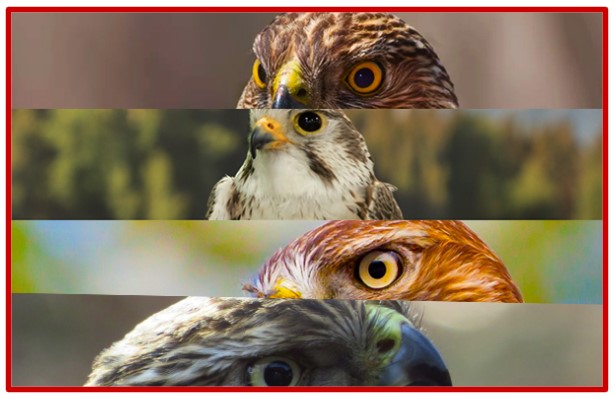Hoosier History Live is an independently produced new media project about Indiana history, integrating podcasts, website www.HoosierHistoryLive.org, weekly enewsletter, and social media. Its original content comes initially from a live with call in weekly talk radio show hosted by author and historian Nelson Price. You can hear the show live Saturdays from noon to 1 pm ET at WICR 88.7 fm or stream the show live at the WICR HD1 app on your phone, or at our website.
This show was preempted for UIndy sports
and will Air June 1, 2024
Click here to visit the original.
May 11, 2024
Birds of prey in Indiana: encore

 Probably the best way to swoop in and do a show that explores birds of prey in Indiana is to invite, as a guest, a wildlife expert who travels across the state accompanied by an assortment of live birds for educational purposes. Mark Booth, the director of Indianapolis-based Take Flight! Wildlife Education, is Nelson's guest on this encore of a show originally broadcast in 2022 to share insights about various species of birds of prey. And to dispel misconceptions about them.
Probably the best way to swoop in and do a show that explores birds of prey in Indiana is to invite, as a guest, a wildlife expert who travels across the state accompanied by an assortment of live birds for educational purposes. Mark Booth, the director of Indianapolis-based Take Flight! Wildlife Education, is Nelson's guest on this encore of a show originally broadcast in 2022 to share insights about various species of birds of prey. And to dispel misconceptions about them.
Hawks, falcons, owls and vultures will be among the birds that we spotlight during our show with Mark, who does outreach programs at schools, museums, clubs and nature centers. He frequently makes appearances, along with some of his birds of prey, at the Indiana State Fair.
"Are they in a bad mood?" Mark asked his audience during a recent presentation, referring to the glaring stare that's often associated with hawks. As Mark spoke, he was accompanied by a red-tailed hawk, which did seem to be, well, glaring. "No, it's not a bad mood. Hawks find food by their eyesight. They look like that (glare) to keep the sun out of their eyes."
A master falconer, Mark was a senior zookeeper and the head bird trainer for more than 10 years at the Indianapolis Zoo. For several additional years, he was contracted to handle the zoo's bird of prey shows.
 During our show, he will share tips about how to ID backyard raptors and, as he puts it, their "importance to suburban ecosystems". Mark also will share insights about the reintroductions of the bald eagle and the Peregrine falcon to Indiana, including how and why that has been done.
During our show, he will share tips about how to ID backyard raptors and, as he puts it, their "importance to suburban ecosystems". Mark also will share insights about the reintroductions of the bald eagle and the Peregrine falcon to Indiana, including how and why that has been done.
He also will discuss the differences between hawks and falcons. During a recent presentation, Mark explained that the differences primarily involve their coloring and the shape of their wings, not their size. He also noted that hawks primarily eat ground animals including squirrels, mice, rabbits and snakes. In contrast, falcons typically dine on other birds.
Mark also will share insights about owls, including the Barred owl, a species found across Indiana. Known for their spectacular hearing and wide, flat face, Barred owls are primarily nocturnal and fond of mice. Many popular Indiana ghost stories involve a barn owl, Mark notes.
 An avid outdoorsman with a distinctive, white beard, Mark says he has been teaching Hoosiers about nature and wildlife since his first job as a teenage instructor at a Cub Scout camp in Marion County.
An avid outdoorsman with a distinctive, white beard, Mark says he has been teaching Hoosiers about nature and wildlife since his first job as a teenage instructor at a Cub Scout camp in Marion County.
This won't be Hoosier History Live's first foray into the state's natural heritage regarding birds. Three years ago, we explored a range of topics, including an illness that was affecting songbirds like robins, cardinals and blue jays, in a show with Don Gorney, former director of bird conservation and education for Amos Butler Audubon.
Don also was among the guests on a show in 2014 that explored the extinct passenger pigeon, which was abundant in Indiana during the 19th century. The last passenger pigeon in the wild anywhere was killed in Indiana in 1902.
Your contributions help keep Hoosier History Live on the air, on the web, in your inbox, and in our ARCHIVES!

Latest Podcast Available!

For a complete list of show podcasts and show enewsletters, please go to ARCHIVES on our website.


 A public dedication was held on April 24, 2024 for the installation of the new Indiana Historical Bureau Syrian Quarter marker, which was placed right outside Lucas Oil Stadium in downtown Indianapolis.
A public dedication was held on April 24, 2024 for the installation of the new Indiana Historical Bureau Syrian Quarter marker, which was placed right outside Lucas Oil Stadium in downtown Indianapolis.
